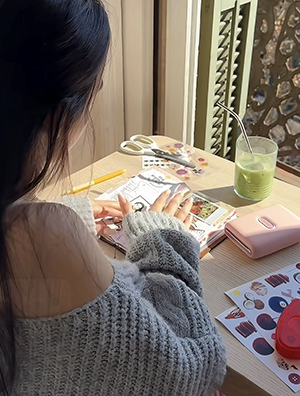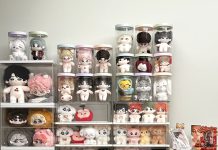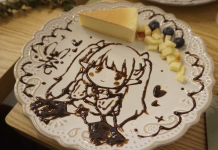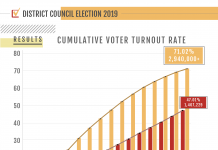Scrapbook enthusiasts embrace handmade journals to preserve memories.
By Flavia Zhou
University student Evelyn Chan-yun has been making scrapbooks for nine years to record her daily life and memorable moments.
Chan likes using hand-drawn stickers and tapes in scrapbooks.
“Hand-drawn stickers and tapes are exquisite handwork. I don’t like e-journals. I like to write with pen and paper. The feeling of touch helps me relax after studying,” the 20-year-old student says.
Owning two smartphones and one tablet, she only uses them in class and checks PowerPoint slides for revision.
The scrapbook enthusiast journals daily events and makes to-do lists two to three times a week.
“Sometimes, I draw some pictures like emojis and food to make my scrapbook beautiful and memorable. My journal is more than just a record of my life. It is an artwork,” the Economics major student says.

(Photo courtesy of Evelyn Chan-yun)
Office worker Esther Lee shares Chan’s passion for making scrapbooks. She confines her use of electronic devices to work. For personal life, she makes five to six scrapbooks a year to preserve memories.
“I express my feelings with words and paintings. I also enjoy junk journaling by sticking supermarket receipts and packaging from noodles in my scrapbook, it’s a personal and creative touch,” the 24-year-old office worker, who lives in Canada, says.
“I make records of special days like birthdays and outings with friends with photos and my writing. I decorate pages with stickers featuring the same theme,” she says.
Lee sees scrapbooks as a tool for understanding herself and appreciating the small moments in life.
“I started this habit during a tough time, seeking a way to vent. Scrapbook was the solution. Writing served as an emotional outlet and regulator. It helps me grow more introspective and reflective, allowing me to better understand myself and comprehend my experiences,” she adds.
Alexia Schriver is another scrapbook maker who appreciates the essence of preserving memory in tangible form. The student who lives in the UK started scrapbooking in July 2024.
“I make records of my daily life and special occasions. I want to preserve my memories in a physical format because it’s easier to look back on. Digital memories can disappear at any time,” she says.
She has been collecting restaurant receipts, clothing label tags, food packaging bags, scenic spot tickets, and movie tickets for one year. She puts them in her scrapbook to keep track of her life. She turns all her collection that others might consider as rubbish into materials for making her scrapbooks.

(Photo courtesy of Alexia Schriver)
“I started doing scrapbooks because I had so much junk sitting in a box in my room. I decided to start using it in a journal and haven’t stopped since I think everything in life triggers my memory. I keep collecting all sorts of paper tickets, receipts, and bags,” Schriver says.
“I am willing to spend time on decorating my scrapbook because I want it to be a representation of my current aesthetics—colors, patterns, styles, and stickers that I like. I don’t have a specific style preference. I enjoy more chaotic spreads with lots of junk because it reflects how much I did that day or week, and it’s nice to look back on,” she adds.
Schriver runs an Instagram page with 27,000 followers and a Xiaohongshu page with 2,700 followers, sharing her scrapbook inspirations and videos on how she does her own journal.
“I hope to encourage others to give journaling a try, as well as to help those who are already journaling with layout ideas or motivation to maintain the habit. The Internet can transcend spatial distances, people with the same hobbies can be found,” the scrapbook enthusiast says.
“I think it is a great way to disconnect from the internet and create analog memories. It helps me ground myself and gives me room to reflect on my days,” she adds.
Part-time lecturer Jenny Leung Kit-wah from the School of Journalism and Communication of the Chinese University of Hong Kong points out that scrapbooking fosters a stronger personal and emotional connection and satisfaction.
“Most handmade goods have a strong story from the producer. It represents or creates a sense of distinctiveness, uniqueness, design idea, and story. It is also the only creation in the world,” Leung says.
“Scrapbooks carry priceless memory, emotional value, and personal connection. It also has effort, ideas, time, and love behind it. Not the piece itself, but the moment, the joy, and the making process are all translated into eternal memory,” she adds.She also points out that reading with a digital device can never be compared with holding a physical item with.
“It demonstrates personalized creativity and innovation. It transcends the 2D limitations with the ability to build 3D models for painting. The smells from paper go beyond visual but project a five-sensory feeling that e-records can never compare. All in all, it creates a sensory moment each time you see it, touch it, and FEEL it,” she adds.
Edited by Angel Yu & Emma Wei
Sub-edited by James Cheang







































